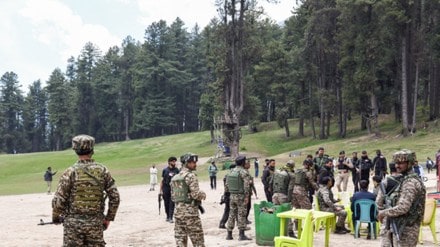During the debate in both Houses of Parliament last week, the government gave the impression that Operation Sindoor had been finally paused, the goals had been achieved, and it is back to the usual way of doing things. That would be wrong. The truth is, the military was playing a tough game when the civilian government forcibly snatched the ball.
Operation Sindoor has busted some myths: that fighting a war against Pakistan will be easy, that India’s superiority in conventional war will prevail, and that India has friends and Pakistan none.
Military vs Political
The military leadership was exemplary. Apparently, they asked for and got operational freedom. The Indian armed forces’ first-mover advantage gave them early wins: 9 places that hosted terrorist infrastructure were demolished and several terrorists were killed. However, Pakistan’s armed forces quickly recovered. They counter-attacked on May 7-8 using China-made aircraft (J-10), China-made missiles (PL-15) and drones acquired from Türkiye.
Realising that ‘tactical mistakes’ had been made, the military leadership paused the operation and ‘re-strategised’. That is leadership. It re-launched the Operation on May 9-10, struck at 11 military airbases and severely damaged them. Inevitably, the Indian armed forces suffered some ‘losses’, and the Chief of Defence Staff and the Deputy Chief of Army Staff admitted the losses. That too is leadership.
Contrast the political leadership. It will not admit the mistakes or the losses. Like an ostrich whose head is buried in the sand, it maintains that India scored a ‘decisive victory’ in Operation Sindoor. If there was a decisive victory, why did India not press its advantage, secure more military gains, and demand and obtain from Pakistan political concessions? Why was the first outreach by the DGMO, Pakistan accepted immediately and without conditions? There were no answers from the government. [A celebrated example of a decisive victory was the surrender of Pakistan’s General Niazi to India’s Lt General Aurora on December 16, 1971.]
Hard realities
Nor will the political leadership acknowledge the reality: Pakistan and China have forged strong military and political bonds. China is supplying new generation fighter aircraft and missiles to Pakistan. Obviously, China was testing its military hardware in a battlefield in a real war. The military bond is visible. On the political front, China’s foreign minister Wang Yi praised Pakistan’s “resolute action on terrorism”. China also voted in favour when IMF, World Bank and Asian Development Bank approved large amounts of loans to Pakistan.
The other reality is that Pakistan’s (at least the Pakistan military’s) bonds with the United States are firmly in place. President Trump invited General Asim Munir, Pakistan’s Army Chief, to lunch at the White House, an unprecedented honour to a person who is not Head of State or Head of Government. Mr Trump thanked General Munir “for not going into the war and ending the war”, and gloated again that he had brought about the ceasefire.
The Prime Minister and the Home Minister do not miss an opportunity to rebuke the Opposition but dare not rebut or refute President Trump or President Xi or their foreign ministers.
The overwhelming reality is that the US and China are on the same page in their support to Pakistan militarily, politically and economically. Keeping aside their differences, the US and China have decided to support and patronise Pakistan. Worse, every country to which India reached out offered sympathy for the victims of the Pahalgam attack and condemned terrorism but did not condemn Pakistan as the perpetrator. India’s political leadership refuses to acknowledge the reality and continues to nurture the false belief that Pakistan is friendless and India has friends all over the world.
Infiltrators & India-based
The other delusion of the Indian political leadership is that the ‘terror ecosystem’ has been smashed in Jammu & Kashmir. The truth is different. Ministry of Home Affairs disclosed to the all-party meeting on April 24, 2025 (immediately after the Pahalgam attack on April 22) that, between June 2014 and May 2024, there were —
- 1,643 terrorist incidents,
- 1,925 infiltration attempts,
- 726 successful infiltrations, and
- 576 security personnel killed.
Undeniably, there were terrorist incidents and casualties in the governments of A B Vajpayee (1998-2004) and Manmohan Singh (2004-2014) as well.
The terror ecosystem is populated by Pakistan-based infiltrators and India-based extremists, especially in Kashmir. Often, they work together, strike together and help each other. On April 26, the government demolished several houses in Kashmir of suspected ‘terrorists associated with the Pahalgam massacre’ — the owners were obviously India-based. In June 2025, the National Investigation Agency (NIA) arrested two Indians for harbouring the suspected terrorists. The suspected terrorists were neutralised on July 27-28 and identified as infiltrators.
India-based terrorists have committed terrorist attacks in the past. For example, Mumbai witnessed terror attacks in 2006 (suburban train bomb blasts), 2008 (Tajmahal Hotel) and 2011 (Zaveri Bazaar). The 2006 incident was committed by India-based terrorists, the 2008 attack was by 10 Pakistani infiltrators including Kasab, and the 2011 incident was by India-based terrorists. The government’s claim that the terror ecosystem in India has been dismantled is manifestly wrong.
The failure of intelligence and the absence of security forces in Pahalgam led to the tragedy. No one in the government has taken responsibility. The military’s gains in Operation Sindoor will have a deterrent effect on Pakistan but the political leadership’s timidity before the US and China may cancel the gains and give encouragement to Pakistan.
